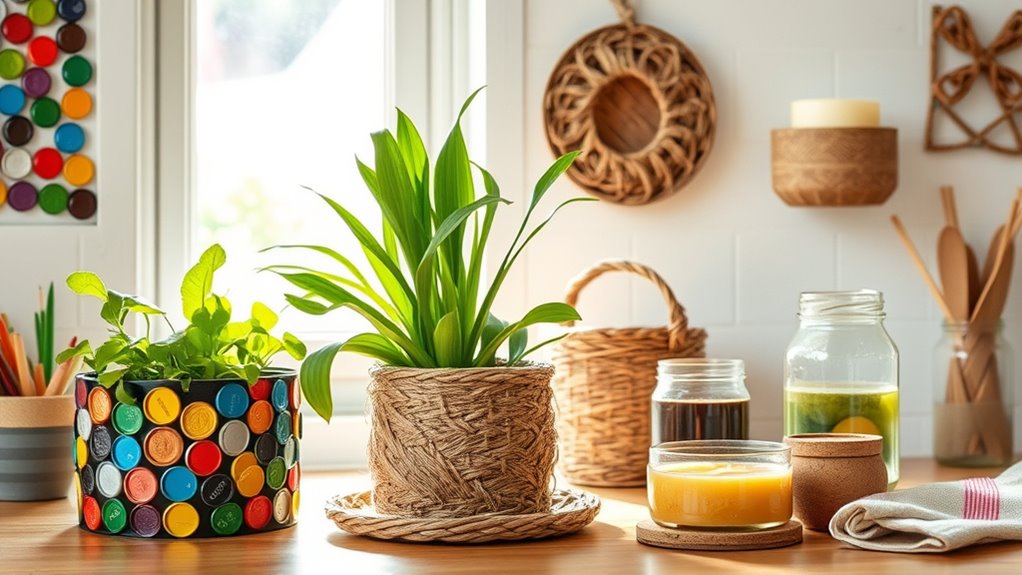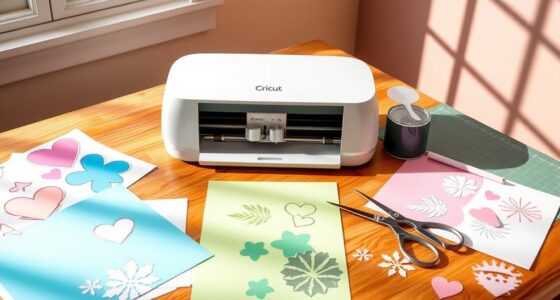To reduce waste, try using old jars as stylish storage with decorative touches, craft herb gardens from upcycled tin cans, and turn old T-shirts into reusable shopping bags. You can also create unique decor from scrap wood and make planters from plastic bottles. Repurpose used candle holders into candles and design jewelry from recycled materials. Building compost bins from pallets completes eco-friendly projects. Keep exploring for more creative ways to live sustainably and reduce household waste.
Key Takeaways
- Repurpose glass jars with labels and decorative touches to store pantry staples or craft supplies sustainably.
- Create eco-friendly planters from upcycled tin cans and plastic bottles, incorporating drainage and personalized decorations.
- Make reusable shopping bags from old T-shirts and craft candles using used candle holders to reduce household waste.
- Design jewelry and home decor using scrap wood pieces and recycled materials, turning waste into unique, stylish items.
- Build compost bins from pallets to recycle kitchen and yard waste, promoting sustainable gardening practices.
Upcycled Tin Can Herb Garden
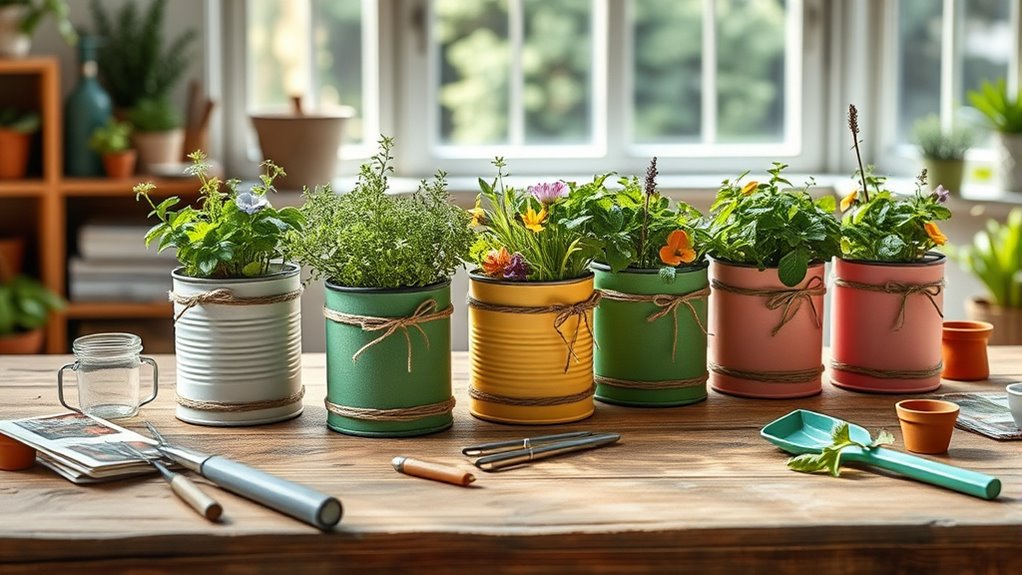
Transforming old tin cans into a herb garden is an easy and sustainable way to add fresh flavors to your cooking. First, clean the cans thoroughly and remove any sharp edges by sanding or pounding down the rims.
Then, drill small drainage holes at the bottom to prevent waterlogging. Fill each can with well-draining soil and plant your favorite herbs like basil, parsley, or cilantro.
Place your cans in a sunny spot, preferably near a window or balcony. This approach not only reuses materials but also keeps your herbs accessible for daily use.
Plus, it’s a compact solution perfect for small spaces. With minimal effort, you create a beautiful, eco-friendly herb garden that’s both functional and decorative.
Repurposed Glass Jars as Storage Containers
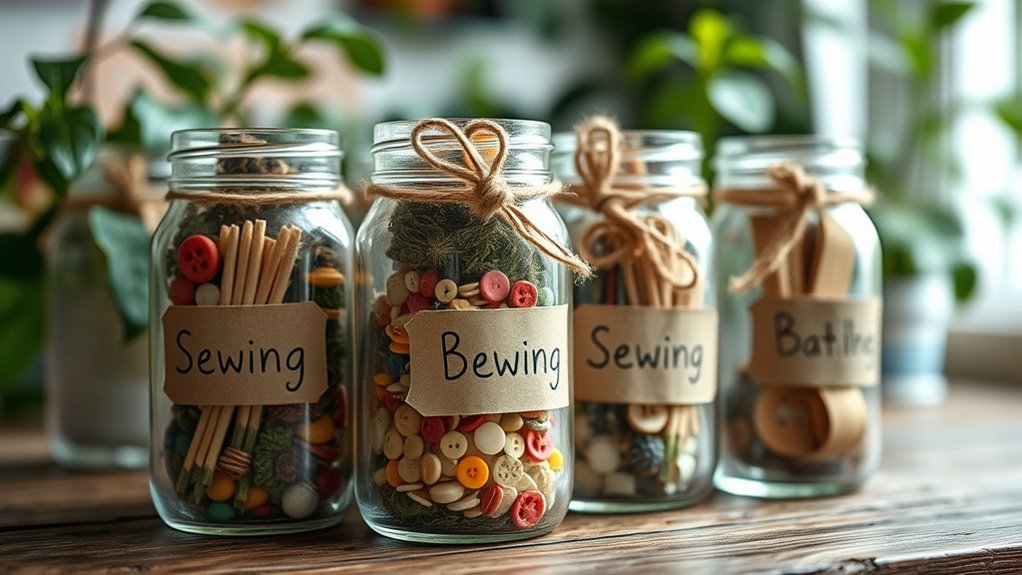
Repurposed glass jars make for both stylish and practical storage solutions around your home. You can easily customize them with paint, labels, or fabric to match your decor. Additionally, incorporating vintage textiles like dish towels or aprons can enhance the farmhouse charm of your storage area farmhouse kitchen textiles. Using self-watering plant pots as storage containers is also an eco-friendly way to keep your space organized while reducing waste, especially when you craft your own from recycled materials self watering planters. Incorporating textile techniques such as embroidery or appliqué can add decorative touches to your repurposed jars, elevating their aesthetic appeal. Applying sustainable practices waste reduction further minimizes your environmental impact and promotes eco-conscious living.
Stylish Storage Solutions
Glass jars are a stylish and sustainable way to organize your space. They add a charming, vintage touch while reducing plastic waste. You can use them to store everything from pantry staples like grains, spices, and dried herbs to small craft supplies such as buttons, beads, or sewing notions. To enhance their look, consider removing labels and cleaning them thoroughly. You might even decorate the lids with paint, fabric, or twine for a personalized touch. These jars are versatile and easy to customize, making your storage both functional and attractive. Plus, repurposing glass jars keeps waste out of landfills and gives new life to materials you already have. Incorporating sound healing science helps improve site functionality and user experience, ensuring your craft storage remains seamless and enjoyable. Using natural materials in your organization can further support eco-friendly practices and complement your sustainable lifestyle. Additionally, embracing AI-powered tools can streamline your organization process, making it easier to find and manage your supplies efficiently. Exploring eco-friendly storage options can also help reduce environmental impact while keeping your home organized.
Personalization Opportunities
You can easily personalize your glass jars to match your style and needs by decorating their lids or adding labels. Use paint, washi tape, or fabric scraps to give lids a unique look that complements your decor. Customizing storage containers can enhance both their functionality and aesthetic appeal. Adding a personal touch makes your jars more functional and aesthetically pleasing. You might also write inspiring quotes or reminders on the jars themselves. If you’re storing different items, color-code the lids or labels for quick identification. Incorporating upcycling techniques into your projects not only reduces waste but also sparks creativity and resourcefulness. These simple customization options turn plain jars into charming, eco-friendly storage solutions that suit your home’s vibe while reducing waste. Personalizing your jars makes organizing more enjoyable and helps you stay committed to sustainable living. Understanding the importance of Vetted electric bike conversion kits can inspire you to think creatively about resourcefulness and value in your own projects.
Turning Old T-Shirts Into Reusable Shopping Bags
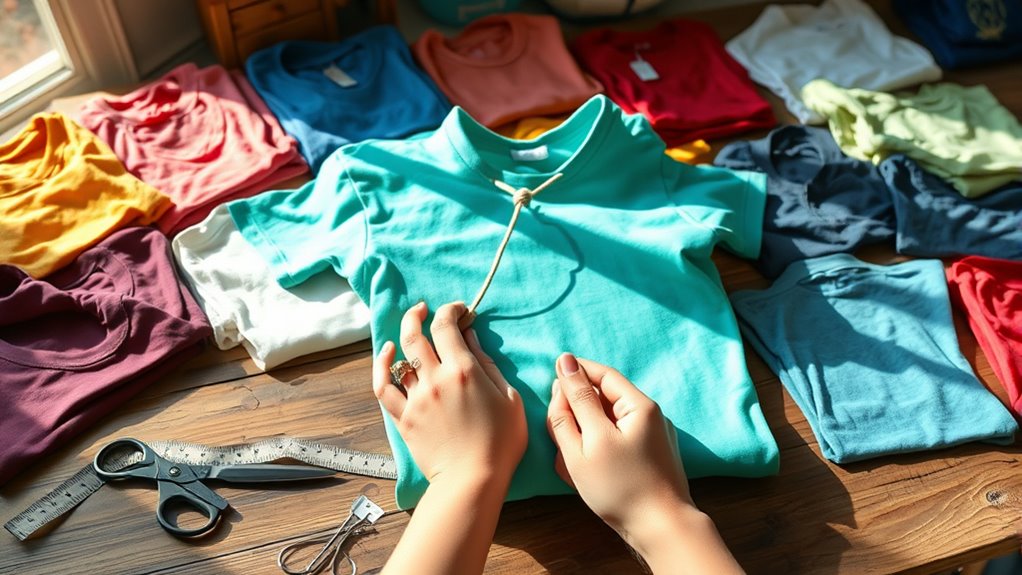
Start by picking an old T-shirt with a sturdy fabric that can handle weight. Then, learn simple sewing techniques to transform it into a durable shopping bag. With the right shirt and a few stitches, you’ll create an eco-friendly alternative that’s easy to make. Incorporating reusable items into your daily routine can help you maintain organization and continue reducing waste over time. To ensure your bag is secure and functional, consider adding reinforced handles or a sturdy bottom panel, which can also improve durability for long-term use. Engaging in DIY hackathons can further inspire innovative approaches to sustainable crafts and waste reduction, especially when using pimple patches to repurpose materials creatively.
Choosing the Right T-Shirt
How do you choose the best T-shirt for turning into a reusable shopping bag? Start with a sturdy, well-made shirt that’s free of tears or stains. Thicker fabrics like cotton or blends hold up better when you cut and carry groceries, providing durability. Avoid lightweight or flimsy shirts, as they may tear easily or lose shape. For added strength, consider using a wood stove on your bag, which can help distribute weight more evenly. Check for vibrant colors or patterns you like, since these will show on your finished bag. Make sure the shirt is clean and free of excessive embellishments that could complicate cutting or sewing later. Opt for a size that gives enough material—usually large or extra-large shirts work well—so your bag can hold more.
Picking the right T-shirt ensures your eco-friendly project is sturdy, functional, and looks great.
Simple Sewing Techniques
Creating a reusable shopping bag from an old T-shirt is simpler than it might seem, especially with basic sewing techniques.
First, cut off the sleeves and neckline to create an open-top bag.
Turn the T-shirt inside out, then sew across the bottom edge using a straight stitch to close it. For added durability, double-stitch or zigzag the seam.
Next, fold the top edge inward about an inch and sew a hem to prevent fraying.
You can reinforce the handles by sewing along the shoulder seams or creating fabric loops.
If you want stronger handles, cut strips from the T-shirt’s side seams and attach them securely.
With these simple techniques, you turn an old T-shirt into a sturdy, eco-friendly shopping bag, reducing waste effortlessly.
Creating Decor With Scrap Wood Pieces

Using scrap wood pieces is a simple and eco-friendly way to add unique decor to your home. You can create charming signs or wall art by sanding and painting small wood scraps.
Create unique home decor by repurposing scrap wood into signs, wall art, or accents with paint and carving.
Arrange them into patterns or meaningful shapes, then glue or nail them together for a rustic look. Consider carving or burning designs into the wood for extra detail.
Wooden coasters or trivets can also be crafted from larger pieces, giving them a polished finish with minimal waste. Recycling old wood not only reduces waste but also adds natural texture and warmth to your space.
Plus, these projects are easy to customize with paint, stain, or embellishments, making your decor truly one of a kind. It’s a practical way to repurpose and personalize your environment sustainably.
Making Planters From Plastic Bottles
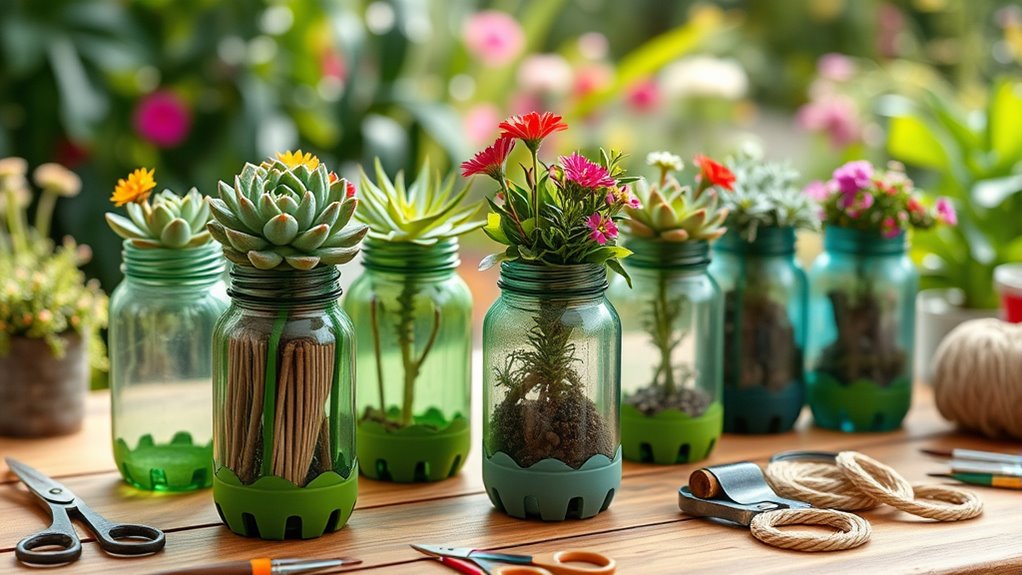
Transforming plastic bottles into planters offers a simple and sustainable way to repurpose waste while adding greenery to your space. Start by cleaning the bottles thoroughly, then cut them in half or into desired shapes. You can punch drainage holes at the bottom to prevent waterlogging. Decorate the outside with paint, fabric, or twine for a personalized touch. Place your new planters in sunny spots and fill them with soil and your favorite plants. This method reduces plastic waste and creates charming, eco-friendly decor.
| Step | Tips |
|---|---|
| Cutting the bottle | Use scissors or a craft knife carefully. |
| Adding drainage holes | Poke holes with a heated nail or screwdriver. |
| Decorating | Use non-toxic paints or natural materials. |
| Planting | Select plants suited for container growth. |
Crafting Candles With Used Candle Holders

A used candle holder can become a charming centerpiece or cozy accent with a simple craft. Start by cleaning out any remaining wax, then gently heat the holder to remove stubborn residue.
Transform an old candle holder into a cozy, stylish centerpiece with simple cleaning and creative repurposing.
You can reuse the holder as a mold for new candles or fill it with melted wax mixed with essential oils and dried flowers for added scent and visual appeal. Use old wicks or cut new ones to fit the holder’s size, securing them with a bit of wax or glue.
Once poured, let the candle cool and harden before trimming the wick. This eco-friendly project not only repurposes what would be waste but also creates personalized candles that add warmth and ambiance to your space.
It’s a sustainable way to enjoy candlelight without extra waste.
Designing Jewelry Using Recycled Materials
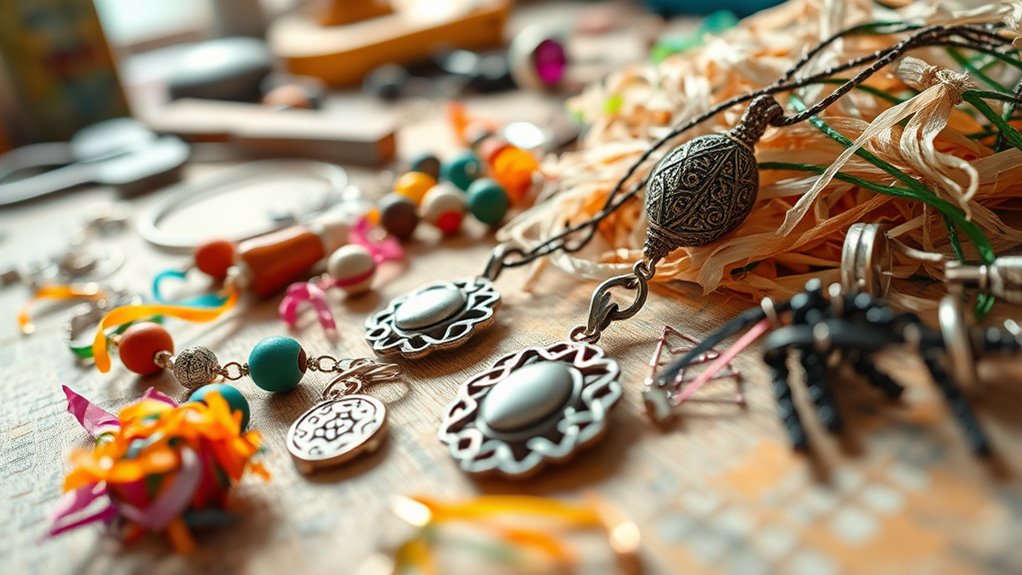
Ever considered how your old jewelry and discarded materials can become stunning, one-of-a-kind pieces? You can transform broken necklaces, buttons, or charms into fresh accessories with just a few supplies.
Start by gathering your recyclable materials—think bottle caps, fabric scraps, or vintage beads. Use pliers, wire, or glue to assemble unique designs that reflect your style.
For example, bottle caps can become pendant bases, or fabric scraps can turn into colorful bracelets. Not only does this reduce waste, but it also adds a personal touch to your jewelry collection.
Experiment with different textures and colors, and don’t be afraid to mix unexpected items. Designing jewelry from recycled materials is a fun, eco-friendly way to create meaningful accessories while giving new life to items you’d otherwise toss away.
Building a Compost Bin From Pallets
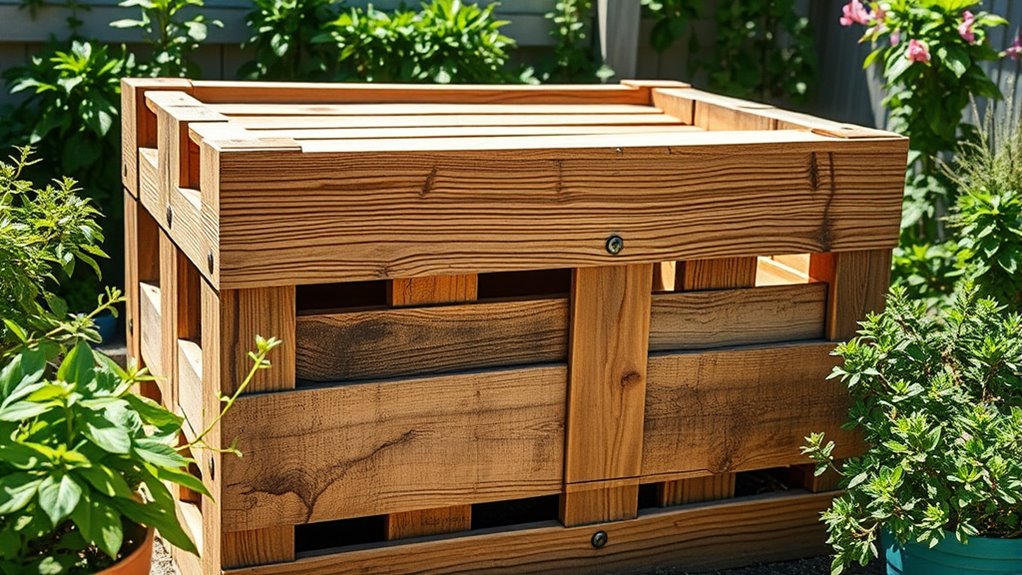
Building a compost bin from pallets is an easy and cost-effective way to start composting at home.
First, gather four pallets of similar size. Arrange them into a square on a level surface, forming the sides of your bin. Secure the pallets together with screws or nails, ensuring stability.
Leave one side open or attach a door for easy access and turning of compost. Make sure the bottom is elevated slightly to allow airflow and drainage.
You can add a lid or cover to keep pests out and maintain moisture.
Fill your bin with kitchen scraps, yard waste, and other compostable materials. Regularly turn the pile to aerate, and in a few months, you’ll have rich compost to use in your garden.
Frequently Asked Questions
How Can I Personalize My DIY Eco-Friendly Crafts for Special Occasions?
You can personalize your DIY eco-friendly crafts for special occasions by adding meaningful touches like handwritten messages, customized colors, or themed decorations that reflect the event’s vibe.
Use natural dyes or upcycled materials to make each piece unique. Incorporate personal photos or symbols that hold significance.
What Safety Precautions Should I Take During DIY Eco-Craft Projects?
Think of safety as your guiding star during DIY projects. You should wear protective gear like gloves and goggles to shield yourself from potential hazards.
Work in a well-ventilated area, especially when using strong adhesives or paints.
Keep tools organized and handle sharp objects carefully.
Avoid rushing, and follow instructions closely.
Prioritizing safety guarantees your creativity flourishes without risking injury or accidents, making your eco-crafts both fun and safe.
How Do I Choose Eco-Friendly Materials for Crafting?
When choosing eco-friendly materials, you should look for options that are biodegradable, recyclable, or made from sustainable sources. Read labels carefully to avoid harmful chemicals and opt for natural fibers like cotton, hemp, or bamboo.
Support local or small-scale producers to reduce carbon footprints. Always consider the lifecycle of the materials, aiming for items that can be reused or composted easily.
Helping you craft sustainably and responsibly.
Can These Crafts Be Suitable for Children’S Activities?
Absolutely, these crafts can be suitable for children’s activities if you choose age-appropriate materials and supervise their use. Kids love hands-on projects that are safe and engaging.
Use non-toxic, washable supplies, and keep small parts away from young children to avoid choking hazards.
With proper guidance, these eco-friendly crafts not only provide fun but also teach kids the importance of reducing waste and caring for the environment.
How Do I Maintain and Clean My Recycled Craft Items Over Time?
Imagine your recycled crafts as delicate gardens, needing gentle care. To keep them looking their best, dust them regularly with a soft cloth, and clean surfaces with a damp, non-abrasive sponge.
Avoid harsh chemicals; instead, use natural soap if needed. Store your creations in a dry, shaded spot to prevent deterioration.
With mindful maintenance, your eco-friendly crafts stay vibrant and beautiful, inspiring sustainable creativity every day.
Conclusion
You might think these projects take too much time, but they truly save you money and help the environment. Plus, crafting your own eco-friendly items gives you a sense of accomplishment and reduces waste. Even if you’re busy, starting small with one or two ideas can make a big difference. So go ahead—get creative, have fun, and feel good knowing you’re making a positive impact on the planet.
